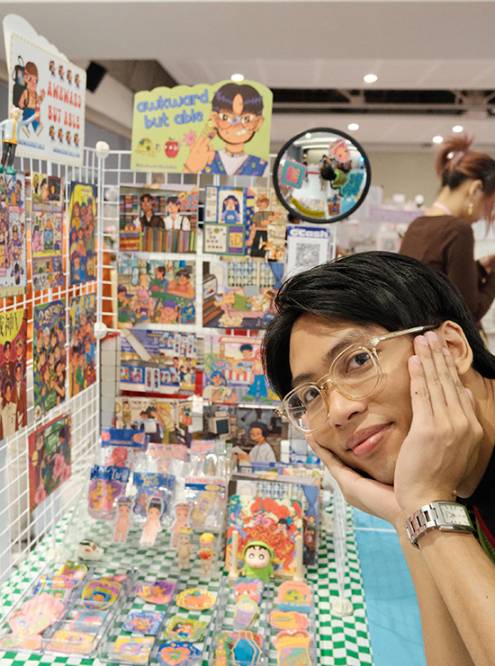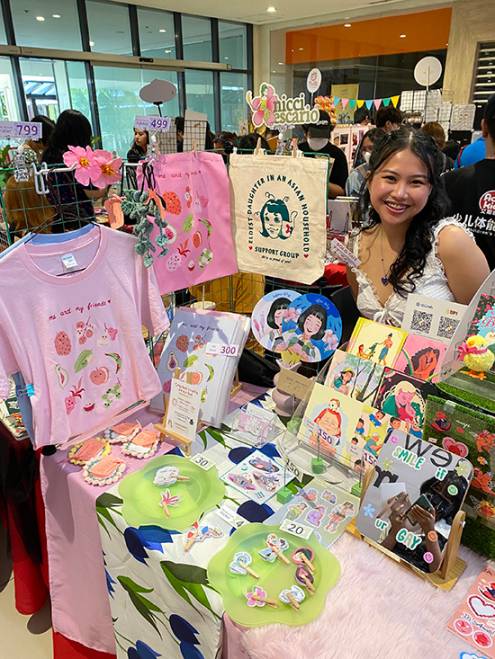Have art markets gone too far?
The Filipino art scene has been experiencing a renaissance. Artists are getting more opportunities to showcase their work, and they get to sell them on a larger scale through Komiket, Stickercon, and other pop-up art markets.
While this may seem great on paper, the demand is gradually starting to surpass the supply. Not only are audiences bombarded with the increasing frequency of these events, but artists are pressured to rapidly pump out new content to keep up.
Have art markets gone too far? Young STAR approached three merchants to weigh in: Julia Sediaren (@j.sedigns), an Information Design student, graphic designer and pop culture fanatic; Cyrill Acuña (@awkwardbutable), an illustrator known for his kitschy, vibrant characters; and Nicci Escario (@niccidraws), a Pangasinan-based artist whose illustrations invoke fun, warmth and nostalgia.
Art markets and how they’ve changed
All three artists have felt a shift in the art market scene ever since the lifting of the COVID-19 restrictions.
Julia, who first attended art markets five years ago, can't help but reminisce. At 13, witnessing talent outside fine arts-exclusive spaces inspired her to table at art markets later on. “The art scene was so different back then. Artists just sold what they liked and there was such a demand for it.”
Nicci attributes this drastic change to inflation. “Ang hirap ngayon ng pera. Kaya mas maraming gustong mag-table.” While she understands the pressure to earn money, she feels a certain sadness as the competition stiffens with more and more artists signing up.

The spike, according to Cyrill, has led to “con burnout.” Art markets are especially saturated in Metro Manila, and he says some organizers are solely in it for the profit as table fees also continue to rise. To him, only a select few are trying to empower artists and bring something new to the table.
Balancing marketability with artistry
A major downside to the oversaturation has been the difficulty of defining one’s art practice outside these markets. These artists not only create their own merchandise but often produce and advertise it, adding more pressure to make their hard work worthwhile.
“These days, parang sobrang nagbabank on (‘yung) artists sa kung ano ‘yung magkakaroon ng mass appeal,” Nicci says. “Kahit malungkot ‘yun, hindi mo naman sila masisisi kasi syempre, gusto nila na mabalik din ang binayad nila sa table (at) kung ano ‘yung mga expenses nila.”
She shares her struggle of finding the balance between making art that interests her and art that appeals to a larger audience. "I don’t want to feel like I’m selling myself out. Pero kailangan kong gawin kasi gusto ko rin na mababawi ‘yung mga (ginastos) ko.”
Cyrill feels conflicted, too. “Wala namang masama if they want to do that, pero at the same time, nahuhurt ako na they create art and think to themselves if (it) is sellable or not. Parang nagiging commodity na sila which is very sad to see.”

Cyrill brings up an old online post that he returns to when creating art to sell. “Kapag gagawa ka daw ng merch, you have to look sa mga (art) con or social media. Tapos you have to find artwork na gusto mong makita pero hindi mo siya nakikita sa market. ‘Yun ang gawin mong merch.”
“At the end of the day, everyone wants money and what’s trending sells,” Julia says. She stresses how prioritizing marketability, even with her own merch, diminishes the beauty of unbridled creativity. “We’re losing focus of the essence of what matters. If we keep creating meaningless things, we’re also wasting our (natural) resources. It’s more important to focus on intention and create meaning in what we put out in the world.”
Creating a more sustainable framework
Although this issue may not be resolved overnight, there are ways to make the culture more conscious of its impact.
The first step, according to Nicci, is to care about the people involved—not just the profit. “Dapat hands-on ‘yung organizations na nagpeprepare nung cons. Kung wala ‘yung mga artists, wala namang pupunta sa events na ‘to. Sana maalagan sila (at) ma-make sure na worth it ‘yung effort nung artist.”
Nicci has a call for both organizers and artists. “Sana lang piliin ng organizers ‘yung mga artists na hindi lang gumagawa ng art to sell. Kawawa naman ‘yung mga customers na gustong makakita ng quality work. Gusto ko (rin) na maging intentional ‘yung artists sa mga ginagawa nilang art para hindi maging monolithic kung ano ‘yung nasa market.”

Cyrill thinks events popping up won’t stop anytime soon, but he believes artists have the power not to give into the current system. “As an artist, you have to gauge if magbebenfit ka or not (from this specific event). Wala naman nagpupush sa artists na, ‘You have to be (here). You have to be (there).’”
“Kahit may ‘con burnout’ or sobrang daming events, ‘di naman yun kasalanan ng artists,” he clarifies. “We do art cons for different reasons, and it’s all valid.”
He also states that customers can support local artists beyond financial means. “A simple retweet or a share to your friends is really appreciated.”
For Julia, building a more sustainable framework is as simple as creating discourse in hopes of a better future. "I want that when we talk about the Philippine art community, we can talk about artists who have individual strengths and distinctive styles but can say it’s very Filipino. I want it to be something we’re proud of.”
For this breakthrough to happen, she advises artists to look within and create with intention. “In the long run, it’s our future selves that we're gonna help. That’s our job as artists at the end of the day—to use our passion to put out a message to the world, and hopefully, that message resonates and makes the world better and happier.”



